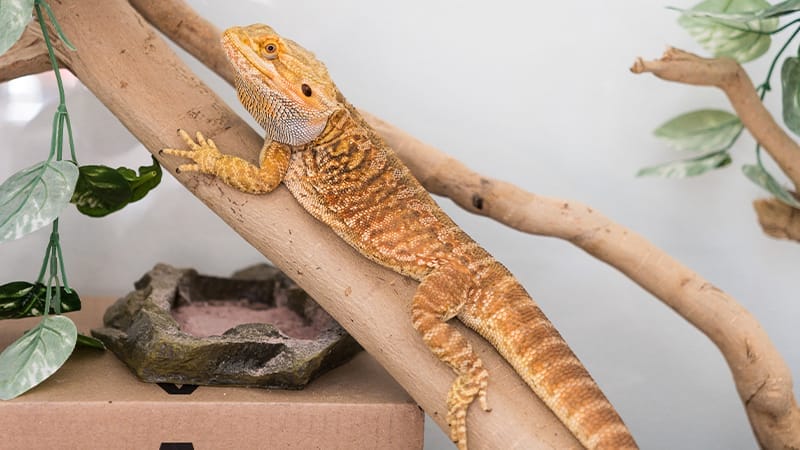Bearded Dragon Care Recommendations
Bearded dragons are social pets. Learn how to care for your beardie properly.
Bearded dragons (beardies) are social animals, which is one of the reasons they are engaging and interesting pets. With proper husbandry and care, they can make wonderful pets for older children and adults.
Housing/Enclosure
Bearded dragon enclosures will need to grow with them as they get bigger. Hatchlings do well in 20-gallon tanks, but adults will require at least a 50-gallon tank. Since they are a terrestrial species, long, short tanks are much better than tall tanks. Their enclosure should be large enough to maintain a temperature gradient vertically and horizontally. Adults are territorial and should be housed alone.
Tanks must be well-ventilated, yet able to retain heat. Make sure the tank has a top to prevent escaping and is large enough and sturdy enough to hold a full-spectrum UV light and a fixture for supplemental heating. It is recommended to use a screen-style top to allow proper ventilation and optimal UVB light and heat lamp exposure. UVB light will not penetrate glass.
Bearded dragons need a spot to hide to feel secure, and to provide an area with higher humidity to maintain hydration and promote normal shedding. We recommend peat moss or a damp paper towel be changed daily. The tank should never be damp.
The best materials (substrates) for the bottom of the enclosures for bearded dragons are paper (butcher, paper towels), reptile carpet, or tiles. Even though in their native environment beardies live in sandy areas, it is not recommended to house them on sand in captivity. Inadvertent ingestion can cause gastrointestinal obstruction, an overly dry environment, and a chronically dehydrated beardie.

Heating and Lighting
Proper lighting and heating are necessary for your beardie’s health and growth. UVB light is necessary for your reptile to absorb and metabolize calcium. A basking area with a basking bulb or ceramic heat emitter, allows the beardie to increase his body temperature, which is necessary for their metabolism. Heat rocks are not recommended since their temperature is not easily controlled and could burn your pet’s skin. It is important to monitor the surface temperature where your beardie will be laying!
- Daytime temperature gradient from 75°F to 85°F with a basking area from 90°F-100°F.
- The nighttime temperature should be no lower than 70°F.
- 12-14 hours per day of UVB emitting light by Reptisun® or Exo Terra. Replace your UVB bulb every six months because UVB bulbs lose their UVB properties over time, even if they are still emitting light.
- Humidity should be maintained between 35-50%.
- Digital thermometers and infrared temperature guns are good tools to monitor and maintain the proper heat for your reptile.

Water
Always provide fresh water for your dragon. It should be in a bowl or dish shallow enough for your lizard to see easily into and drink out of. We recommend soaking your bearded dragon in lukewarm water once weekly.
Sanitation
Weekly cage cleaning should include thorough scrubbing and disinfecting. For washing, use non-toxic soaps such as dish soap. Rinse well. For disinfection, dilute bleach (1:10) and rinse very well. Allow cage to air-dry before the dragon is returned to the enclosure.
Diet
Bearded dragons are omnivores that accept a wide variety of foods. Food should be removed daily. Variety is the key to good nutrition and foods offered should include:
Vegetable Matter: Vegetables offered as a chopped salad, should make up approximately 75-80% of the adult dragon diet. Dark, leafy greens such as romaine, dandelion, turnip greens, mustard greens, bok choy, Swiss chard, and chicory should make up 55-60% of the diet. Carrot tops, collards, and beet greens should be offered sparingly due to their higher amount of calcium oxalates. Avoid spinach and parsley. Other chopped or grated vegetables may comprise up to 20% of the diet (squash, zucchini, sweet potato, broccoli, peas, carrots, beans, okra, and bean sprouts).
Animal Matter: Animal Matter should make up approximately 20% of the adult dragon diet. Appropriately sized crickets (body length 2/3 the size of the dragon’s head), earthworms, superworms, and dubia roaches. Avoid lightning bugs; they are toxic.
Treats/Fruits: Fruit should make up no more than five percent of the diet and should include nutrient-dense items such as papaya, melon, and banana. Offer non-toxic flower blossoms such as hibiscus as occasional treats.
Gut Loading: Feeding insects a nutritious diet ensures the nutrition is passed onto your beardie. Feed dark leafy greens and other vegetables, such as sweet potatoes, carrots, and squash. Commercial cricket diets are also available. Dust prey with a calcium supplement just before feeding them to your lizard three to five times each week (more for baby and pregnant dragons).

Pet Care Resources
For ways to ensure your pet lives a happier, healthier life, visit our Pet Care Resources library.
View ResourcesPet Care Resources
For ways to ensure your pet lives a happier, healthier life, visit our Pet Care Resources library.
View Resources